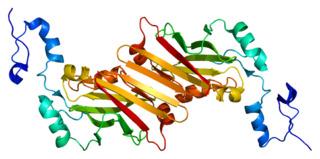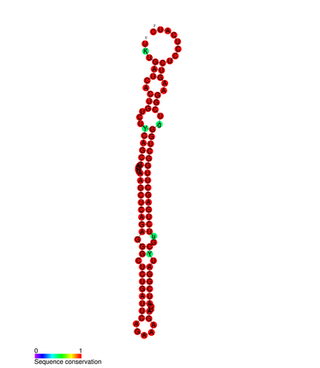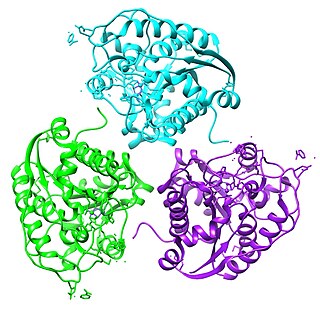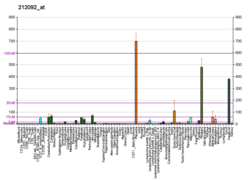
Retrotransposons are a type of genetic component that copy and paste themselves into different genomic locations (transposon) by converting RNA back into DNA through the reverse transcription process using an RNA transposition intermediate.

Endogenous retroviruses (ERVs) are endogenous viral elements in the genome that closely resemble and can be derived from retroviruses. They are abundant in the genomes of jawed vertebrates, and they comprise up to 5–8% of the human genome.

E3 ubiquitin-protein ligase SIAH1 is an enzyme that in humans is encoded by the SIAH1 gene.

Placental growth factor(PlGF) is a protein that in humans is encoded by the PGF gene.

Glypican-3 is a protein that, in humans, is encoded by the GPC3 gene. The GPC3 gene is located on human X chromosome (Xq26) where the most common gene encodes a 70-kDa core protein with 580 amino acids. Three variants have been detected that encode alternatively spliced forms termed Isoforms 1 (NP_001158089), Isoform 3 (NP_001158090) and Isoform 4 (NP_001158091).

E3 ubiquitin-protein ligase SIAH2 is an enzyme that in humans is encoded by the SIAH2 gene.

Solute carrier family 22 member 1 is a protein that in humans is encoded by the gene SLC22A1.

Mesoderm-specific transcript homolog protein is a protein that in humans is encoded by the MEST gene.

Homeobox protein DLX-4 is a protein that in humans is encoded by the DLX4 gene.

Forkhead box protein N3 is a protein that in humans is encoded by the FOXN3 gene.

Paternally-expressed gene 3 protein is a protein that in humans is encoded by the PEG3 gene. PEG3 is an imprinted gene expressed exclusively from the paternal allele and plays important roles in controlling fetal growth rates and nurturing behaviors as has potential roles in mammalian reproduction. PEG3 is a transcription factor that binds to DNA [11-13] via the sequence motif AGTnnCnnnTGGCT, which it binds to using multiple Kruppel-like factors. It also regulate the expression of Pgm2l1 through the binding of the motif.
Placenta-specific protein 1 is a small, secreted cell surface protein encoded on the X-chromosome by the PLAC1 gene. Since its discovery in 1999, PLAC1 has been found to play a role in placental development and maintenance, several gestational disorders including preeclampsia, fetal development and a large number of cancers.

Protein LDOC1 is a protein that in humans is encoded by the LDOC1 gene.

CAAX box protein 1 is a protein that in humans is encoded by the FAM127A gene.

MEG3 is a maternally expressed, imprinted long non-coding RNA gene. At least 12 different isoforms of MEG3 are generated by alternative splicing. Expression of MEG3 is lost in cancer cells. It acts as a growth suppressor in tumour cells, and activates p53. A pituitary transcript variant has been associated with inhibited cell proliferation. Studies in mouse and sheep suggest that an upstream intergenic differentially methylated region (IG-DMR) regulates imprinting of the region. The expression profile in mouse of the co-regulated Meg3 and Dlk1 genes suggests a causative role in the pathologies found in uniparental disomy animals, characterized by defects in skeletal muscle maturation, bone formation, placenta size and organization and prenatal lethality. The sheep homolog is associated with the callipyge mutation which in heterozygous individuals affects a muscle-specific long-range control element located in the DLK1-GTL2 intergenic region and results in the callipyge muscular hypertrophy. The non-Mendelian inheritance pattern, known as polar overdominance, likely results from the combination of the cis-effect on the expression levels of genes in the DLK1-GTL2 imprinted domain, and trans interaction between the products of reciprocally imprinted genes.

mir-127 microRNA is a short non-coding RNA molecule with interesting overlapping gene structure. miR-127 functions to regulate the expression levels of genes involved in lung development, placental formation and apoptosis. Aberrant expression of miR-127 has been linked to different cancers.

Arginase, type II is an arginase protein that in humans is encoded by the ARG2 gene.

Joomyeong Kim is a Russell Thompson, Jr. Family Professor of Biology at Louisiana State University. His research interests include genomic imprinting and epigenetics. Dr. Kim's laboratory is mainly involved in understanding the functions and regulatory mechanisms governing genes subject to genomic imprinting. Having previously characterized an imprinted domain located on proximal mouse chromosome 7/ human chromosome 19q13.4, his laboratory currently focuses on understanding regulatory mechanisms directing the mono-allelic expression of the seven imprinted genes in the cluster: Peg3, Usp29, Zfp264, APeg3 and Zim1, Zim2, Zim3. As a second project direction, his lab studies the function of the dominant gene in the cluster, Peg3, as a transcriptional regulator. Past projects in the Kim lab have included studying the epigenetic instability of imprinted genes during tumorigenesis, potential roles of AEBP2 as a PRC2 targeting protein and in neural crest cell development, as well as the DNA methylation of mouse and human retrotransposons.

Retrotransposon Gag Like 6 is a protein encoded by the RTL6 gene in humans. RTL6 is a member of the Mart family of genes, which are related to Sushi-like retrotransposons and were derived from fish and amphibians. The RTL6 protein is localized to the nucleus and has a predicted leucine zipper motif that is known to bind nucleic acids in similar proteins, such as LDOC1.

RTL1 is a retrotransposon derived protein coding gene. It is also known as PEG11 and is a paternally expressed imprinted gene, part of genomic imprinting. RTL1 plays an important role in the maintenance of fetal capillaries and is expressed in high quantities during late stage of fetal development. The expression of this gene is important for the development of the placenta, the fetus-maternal interface. Because the placenta is the first organ to form during the development of an embryo, problems in its establishment and biological role lead to complications during gestation. This organ maintains the fetus throughout the pregnancy and is therefore sensitive to disruptions. Studies in mice suggest that disruption of the RTL1 concentration, whether increasing or decreasing the amount of this protein coding gene, can lead to serious errors in the conservation of placental fetal capillaries. RTL1 knockout mice have shown obstruction in fetal development along with late fetal/neonatal death. Studies from sheep homologs suggest that high expression levels of RTL1 can lead to skeletal muscle hypertrophy This is due to over-expression patterns in the paternal allele specific gene.




















